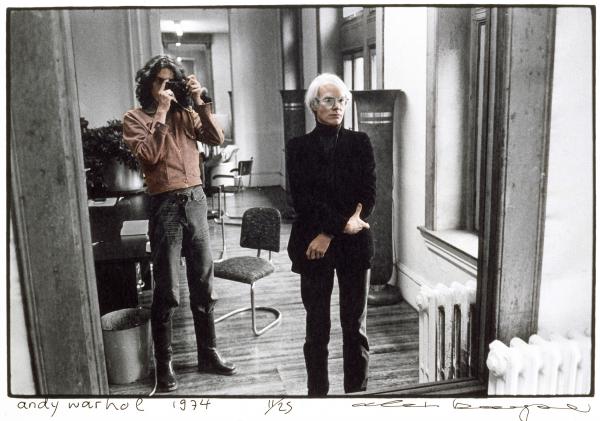Everybody knows the work of Andy Warhol, the legendary artist who conjures up images of Pop art, screenprints, and soup cans. You can see his art at nearly every major museum across the country. While working on an inventory of the Audrey and Sydney Irmas collection for my Collections Management Works on Paper internship, I came across this brilliant image of Andy Warhol. Warhol looks very professional in this photograph, but who is the well dressed young man capturing Andy in his self-portrait?
The man behind the camera is Swiss-born artist Alex Kayser. His loft in New York City became a hub for the arts scene in the 1970s. Warhol would visit the loft among other big names of the time like Samuel Wagstaff, George Maciunas, and Christo and Jeanne-Claude.
This image is somewhat small, smaller than I had remembered from my first encounter with the piece while in LACMA’s Hollywood warehouse. The original image was black and white, and if you look for it online, you will likely find it in that form. This edition seems to be colored in by hand, emphasizing the figures of Kayser and Warhol. The image itself has a small black border surrounded by white and the surface of the photograph is matte. Alex Kayser has signed and dated the right side of the piece and inscribed “andy warhol” to the left. What I find really interesting about this work is that it doesn't seem to be taken in a home, but more of an office setting, if you look closer. I have so many questions about this photograph that I believe will have to remain unanswered.
Audrey and Sydney Irmas compiled with their daughter Deborah Irmas an outstanding collection of self-portraiture. They donated 139 self-portraits to LACMA in 1992. Since then, LACMA has featured the collection in seven national and international touring exhibitions. Some pieces from the collection caught my eye during my trips to Barbara Kruger’s Thinking of You. I Mean Me. I Mean You., which was on view at LACMA earlier in 2022. They were featured in the part of the exhibition where Kruger examines the role of the artist. LACMA published a few books on the collection, including The Camera I in 1994 and This Is Not a Selfie in 2017. A lot changed between the two books, hence the apparent differences in title. With the rise of the mobile phone camera and more accessible digital technology, the fine art self-portrait must be differentiated from the “selfie,” while The Camera I implies a sense of self and agency through the self-portrait. Both books accompanied an exhibition. LACMA exhibited The Camera I in 1994, and This is Not a Selfie was shown in three different venues in 2017 and 2018: the San Jose Museum of Art, Art Center College of Design in Pasadena, and the Museum of Fine Arts Saint Petersburg in Florida.
Alex Kayser was clearly an impressive artist, and yet initially I had been able to find very little about this colleague of Andy Warhol. Only in foto-sequenties, a photobook in Dutch that was available through LACMA’s research library, was I able to find a bit more information outside of his foundation’s website. Even then, what I found was an analysis of another interesting photograph that I had to translate from Dutch using my phone. The photograph appears to be a mirrored image of a bathroom with a door and a person on either side in different positions.
I did some more research and found Alex Kayser’s Artists’ Portraits. Interview by Andy Warhol available online. The Balch Art Research Library and Archives acquired it at my request. I was immediately struck by the fantastical portraits throughout this small rectangular art book. It begins with an interview of Alex Kayser by Andy Warhol, which is even more fantastic than the portraits. In the interview, Alex discusses the fact that all of his photographs are hand colored after originally being shot in black and white. Warhol asks “Why do you color them in?” to which he responds: “I wanted to work in color but didn’t like Kodak colors.” Delving into the numerous artists’ portraits in the book, I recognized a few very prominent names including Salvador Dalí, David Hockney, and Roy Lichtenstein. Kayser discusses Dalí and Hockney in the brief interview with Warhol. The book, of course, ends right back where we began, with the self-portrait of Alex Kayser and Andy Warhol.



